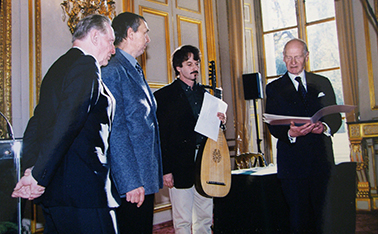About the Liuto forte
Early History
- Lute and guitar – a dilemma?
- Lute and guitar in the 20th century
- Why the lute died out
- Original instruments – original sound?
- The stringing of historical lutes
- Rift between guitar and lute
- Distinctions in sound
- Methods of guitar and lute construction
- The guitar’s limited bass range
About the Liuto forte
- A Lute for the 21st century
- “Guitar-lute“ or “authentic“ lute
- Historical Liuti forti
- Single or double strings?
- Liuto forte sound
- Liuto forte stringing
- Fingertips or nails?
- The belly
- Fine tuning
- The rose
- Fixed or tied-on frets?
- Tuning pegs
- The nut
- The fingerboard
- The bridge
- Playing position
- Playing technique
- Prospects
Liuto forte – a Lute for the 21th Century
In 1999 the “Prix de l’innovation pour les instruments de musique” was awarded in Paris for the creation of the Liuto forte. A new chapter in the history of plucked string instruments had begun.
In contrast to the violin, the guitar or the piano, since the middle of the 18th century the lute had ceased to keep up with developments in European music. It went gradually out of use and by the early years of the 19th century lute playing had died out entirely. It is true that the lute has re-conquered a modest place for itself once more, at least within the limits of historical performance practice. But the position it has today in no way justly reflects the lute’s importance in cultural history – and it neglects its potential, as a living musical instrument, for further development.
The lute’s development was always full of astounding innovations before its final stagnation in the early classical period and this thread deserves to be, not only taken up again, but continued. For this to be begun, it was essential to truly confront the reasons for its becoming extinct, qualities which still stand in the way of its proper recognition in both contemporary music and today’s musical practice as a whole. These are: insufficient volume; over-complicated playing requirements; inability to sing out and sustain a cantabile line; limited richness of tone colour.
As the fruit of many years of experimentation, the lutenist André Burguete, the instrument maker Guenter Mark and the acoustics engineer Benno Streu have managed to successfully develop a new lute, a lute in which the clarity of the ancient lute and the warmth of the Spanish guitar are combined into a powerful and brilliant agent of sound. This Liuto forte is suitable for practically any musical style. It also poses no obstacles to the guitarist.




